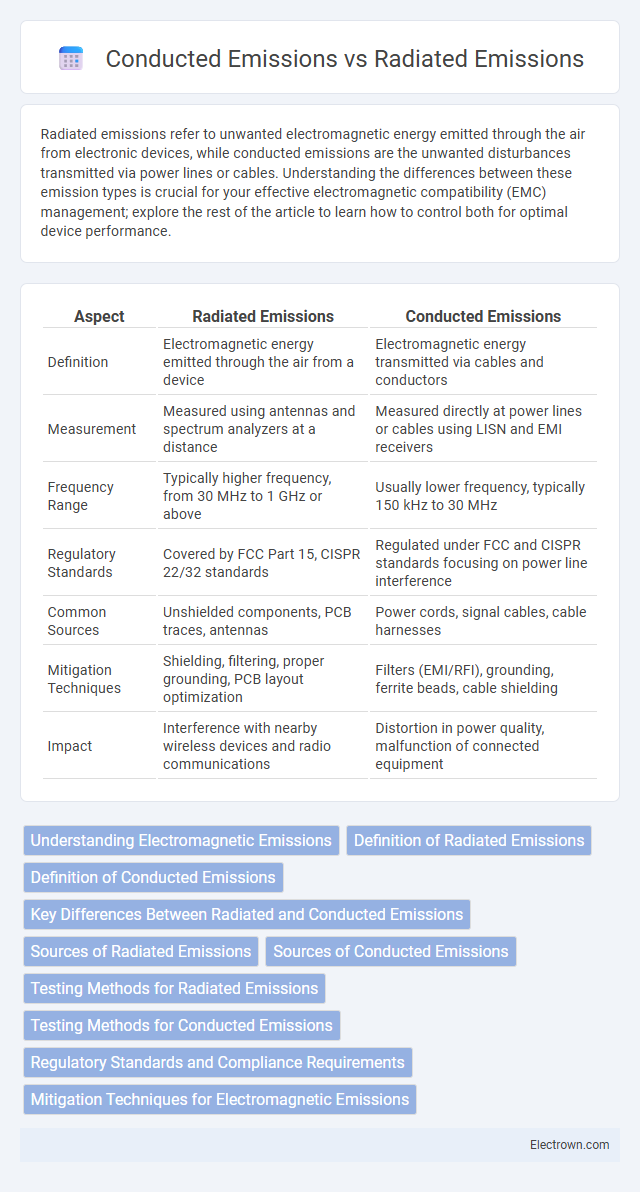Radiated emissions refer to unwanted electromagnetic energy emitted through the air from electronic devices, while conducted emissions are the unwanted disturbances transmitted via power lines or cables. Understanding the differences between these emission types is crucial for your effective electromagnetic compatibility (EMC) management; explore the rest of the article to learn how to control both for optimal device performance.
Table of Comparison
| Aspect | Radiated Emissions | Conducted Emissions |
|---|---|---|
| Definition | Electromagnetic energy emitted through the air from a device | Electromagnetic energy transmitted via cables and conductors |
| Measurement | Measured using antennas and spectrum analyzers at a distance | Measured directly at power lines or cables using LISN and EMI receivers |
| Frequency Range | Typically higher frequency, from 30 MHz to 1 GHz or above | Usually lower frequency, typically 150 kHz to 30 MHz |
| Regulatory Standards | Covered by FCC Part 15, CISPR 22/32 standards | Regulated under FCC and CISPR standards focusing on power line interference |
| Common Sources | Unshielded components, PCB traces, antennas | Power cords, signal cables, cable harnesses |
| Mitigation Techniques | Shielding, filtering, proper grounding, PCB layout optimization | Filters (EMI/RFI), grounding, ferrite beads, cable shielding |
| Impact | Interference with nearby wireless devices and radio communications | Distortion in power quality, malfunction of connected equipment |
Understanding Electromagnetic Emissions
Radiated emissions refer to electromagnetic energy emitted through the air from electronic devices, potentially causing interference with other equipment, while conducted emissions travel along power or signal cables. Understanding electromagnetic emissions involves identifying the source, frequency range, and propagation path to ensure compliance with regulatory standards like FCC or CISPR. Your device's electromagnetic compatibility depends on controlling both radiated and conducted emissions to minimize interference and maintain optimal performance.
Definition of Radiated Emissions
Radiated emissions refer to unwanted electromagnetic energy emitted from electronic devices into the air, which can interfere with other nearby electronic equipment. These emissions are typically measured using antennas and spectrum analyzers to assess their intensity over a range of frequencies. Your electronic device's compliance with radiated emissions limits ensures it does not cause harmful interference in its operating environment.
Definition of Conducted Emissions
Conducted emissions refer to the electromagnetic disturbances generated by electronic devices that travel along power or signal lines, potentially causing interference with other equipment. These emissions are typically measured using line impedance stabilization networks (LISNs) to ensure compliance with regulatory standards such as CISPR and FCC. Understanding conducted emissions is crucial for designing effective electromagnetic compatibility (EMC) solutions to minimize noise propagation through electrical wiring.
Key Differences Between Radiated and Conducted Emissions
Radiated emissions refer to electromagnetic energy that is transmitted through the air from a device, typically measured in the far-field region using antennas, while conducted emissions are unwanted signals traveling along conductive paths like power or signal lines, measured using line impedance stabilization networks (LISNs). Radiated emissions primarily impact wireless communication systems by causing interference over a distance, whereas conducted emissions affect connected equipment directly through shared cables. Compliance testing standards such as CISPR 22 and FCC Part 15 set distinct limits and measurement methods for both emission types to ensure electromagnetic compatibility (EMC).
Sources of Radiated Emissions
Radiated emissions primarily originate from unintended antenna effects in electronic circuits, where high-frequency signals escape through PCB traces, cables, and component leads acting as radiators. Common sources include oscillators, switching power supplies, and clock signals, which generate electromagnetic interference (EMI) that propagates through the air. Understanding these sources is crucial for designing effective shielding and filtering strategies to comply with regulatory standards such as CISPR and FCC limits.
Sources of Conducted Emissions
Conducted emissions primarily originate from electronic devices and power supplies that inject unwanted signals or noise onto power lines or signal cables. These sources include switching power supplies, inverters, motor drives, and digital circuits with rapid switching transients. Understanding these sources is crucial for implementing effective filtering and mitigation techniques to comply with electromagnetic compatibility (EMC) standards.
Testing Methods for Radiated Emissions
Testing methods for radiated emissions involve measuring electromagnetic waves emitted from electronic devices using antennas placed at specific distances, typically 3 or 10 meters, in an anechoic or open-area test site. The device under test operates across its full frequency range while emissions are recorded with a spectrum analyzer or receiver to identify levels exceeding regulatory limits. Your compliance is ensured by following standardized protocols such as CISPR 22 or FCC Part 15 for valid radiated emissions assessment.
Testing Methods for Conducted Emissions
Conducted emissions testing involves measuring electromagnetic interference (EMI) transmitted along power lines or cables using specialized equipment like a Line Impedance Stabilization Network (LISN). These tests are performed in controlled environments following standards such as CISPR 22 or FCC Part 15 to ensure accurate results and compliance with regulatory limits. Proper setup and calibration during your conducted emissions testing can help identify sources of interference impacting device performance and regulatory approval.
Regulatory Standards and Compliance Requirements
Radiated emissions and conducted emissions are regulated under standards such as CISPR 22, FCC Part 15, and EN 55032 to ensure electronic devices do not interfere with other equipment. Radiated emissions limits focus on electromagnetic energy transmitted through the air, while conducted emissions standards address disturbances traveling via power and signal cables. To ensure your device meets compliance, thorough testing against specific limits in these regulations is essential for market approval and avoiding penalties.
Mitigation Techniques for Electromagnetic Emissions
Mitigation techniques for radiated emissions include the use of shielding enclosures, ferrite beads, and careful PCB layout design to minimize electromagnetic interference (EMI) radiation. Conducted emissions are commonly controlled through the implementation of low-pass filters, common-mode chokes, and proper grounding strategies to reduce noise on power lines. Both emission types benefit from component selection that conforms to EMC standards and compliance testing to ensure effective EMI reduction across frequency ranges.
Radiated Emissions vs Conducted Emissions Infographic

 electrown.com
electrown.com